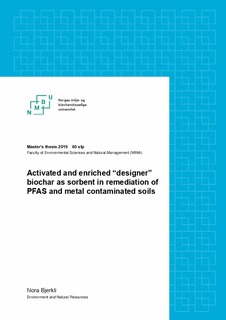| dc.contributor.advisor | Cornelissen, Gerard | |
| dc.contributor.author | Bjerkli, Nora | |
| dc.date.accessioned | 2019-09-02T11:36:47Z | |
| dc.date.available | 2019-09-02T11:36:47Z | |
| dc.date.issued | 2019 | |
| dc.identifier.uri | http://hdl.handle.net/11250/2612018 | |
| dc.description.abstract | Soil contamination has become a major environmental problem of global concern, and there is a need for effective remediation methods to counteract this problem. Immobilisation of contaminants in soil using the carbonaceous material biochar as a sorbent can make an important difference in the future, as it is both a sustainable and cost-effective remediation alternative. However, there is still much unknown about biochar’s sorption capacity for various contaminants and this thesis therefore aims to contribute knowledge to this existing knowledge gap.
In order to investigate the sorption of a group of organic pollutants called per- and polyfluorinated alkyl substances (PFAS) and metals/metalloids (lead, copper, and antimony) to biochar in contaminated soil, one-step batch leaching tests were conducted, with increasing dose of biochar added. Previous research has shown that biochar has potential for improvement as a sorbent material and therefore two types of "designer" biochars were investigated in this thesis. In the PFAS contaminated soil, different activated biochars were tested and in the metal contaminated soil, biochars enriched with zero-valued iron and sulfur were tested.
In soil with low organic matter (OM) content, the addition of activated biochar gave an almost 100% reduction in PFAS leaching already at a dose of 0.5%. Sorption of PFAS in soil with high OM content required a dose of 5% to observe a clear reduction in PFAS leaching. Fully activated biochar gave the most effective PFAS sorption in both soil types. In metal/metalloid contaminated soil, biochar enriched with zero-valued iron had the best ability to sorb both lead, copper and antimony. A dose of 10% was required to get a clear effect in soil with both high and low OM content.
So far, the research on such types of "designer" biochar is scarce. The present work provides promising prospects for biochar as an effective sorbent material in soil remediation. Further research on activated biochar and iron-enriched biochar is needed to gain a better understanding of the sorption capacity and the underlying sorption mechanisms. | nb_NO |
| dc.description.abstract | Jordforurensning har blitt et stort, globalt miljøproblem, og der er behov for effektive behandlings metoder for å motvirke dette problemet. Immobilisering av forurensninger i jorda ved hjelp av det karbonrike sorpsjonsmaterialet biokull kan utgjøre en viktig forskjell i tiden fremover, da det både er et miljøvennlig og kostnadseffektivt behandlingsalternativ. Det er imidlertid mye som gjenstår når det gjelder kunnskap om biokulls evne til å binde ulike forurensninger i jord. Denne oppgaven har derfor som mål å bidra med kunnskap til dette eksisterende kunnskapshullet.
For å undersøke binding av en gruppe organiske forurensninger kalt per- og polyfluorerte alkyl substanser (PFAS) og metaller/metallioder (bly, kobber, og antimon) til biokull i forurenset jord, ble det gjennomført utlekkingstester (one-step batch leaching tests) med økende dose biokull tilsatt. Tidligere forskning har vist at biokull har et forbedringspotensiale som sorbentmateriale, og derfor ble to typer «designer» biokull undersøkt i denne oppgaven. I den PFAS forurensede jorden ble ulike varianter av aktivert biokull testet, mens i den metall/metalloid forurensede jorden ble biokull beriket med nullverdig jern og svovel testet.
I jord med lavt innhold av organisk materiale ga tilsetning av aktivert biokull en nærmest fullstendig reduksjon i PFAS-utlekking allerede ved en dose på 0,5%. Sorpsjon av PFAS i jord med høyt innhold av organisk materiale krevde en dose på 5% for å observere en markant reduksjon i PFAS utlekking. Fullstendig aktivert biokull ga mest effektiv PFAS-binding i begge jordtypene. I metall/metalloid-forurenset jord var det biokull beriket med nullverdig jern som hadde best evne til å binde bly, kobber og antimon. En dose på 10% var nødvendig for å få tydelig effekt i jord med både høyt og lavt OM innhold.
Det er foreløpig svært lite forskning på slike typer «designer» biokull, og resultatene fra oppgaven gir lovende utsikter for biokull som et effektivt sorbentmateriale for behandling av forurenset jord. Videre forskning på aktivert biokull og jernberiket biokull er nødvendig for å få en bedre forståelse for sorpsjons kapasitet og de underliggende sorpsjonsmekanismene. | nb_NO |
| dc.language.iso | eng | nb_NO |
| dc.publisher | Norwegian University of Life Sciences, Ås | nb_NO |
| dc.rights | Attribution-NonCommercial-NoDerivatives 4.0 Internasjonal | * |
| dc.rights.uri | http://creativecommons.org/licenses/by-nc-nd/4.0/deed.no | * |
| dc.subject | Biochar | nb_NO |
| dc.subject | Biokull | nb_NO |
| dc.subject | Activated biochar | nb_NO |
| dc.subject | Designer biochar | nb_NO |
| dc.subject | Soil remediation | nb_NO |
| dc.subject | Forurenset jord | nb_NO |
| dc.subject | PFAS | nb_NO |
| dc.subject | Contaminated soil | nb_NO |
| dc.subject | Contaminant immobilisation | nb_NO |
| dc.subject | ZVI enriched biochar | nb_NO |
| dc.subject | Pb | nb_NO |
| dc.subject | Cu | nb_NO |
| dc.subject | Sb | nb_NO |
| dc.title | Activated and enriched “designer” biochar as sorbent in remediation of PFAS and metal contaminated soils | nb_NO |
| dc.title.alternative | Aktivert og beriket "designer" biokull som sorbent i remediering av PFAS og metallforurenset jord | nb_NO |
| dc.type | Master thesis | nb_NO |
| dc.subject.nsi | VDP::Matematikk og Naturvitenskap: 400 | nb_NO |
| dc.source.pagenumber | 103 | nb_NO |
| dc.description.localcode | M-MINA | nb_NO |

